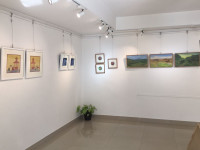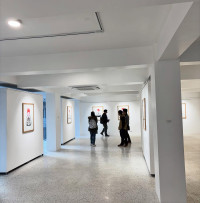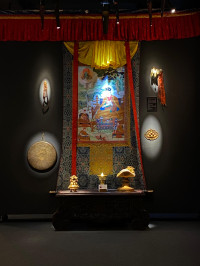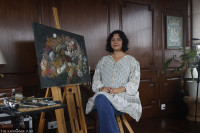Arts
An artist recreates a khaja ghar inside a gallery, but there is no mention of food
While artist Nabendra Limbu re-creates a khaja ghar inside a gallery, there’s much he misses to impress the audience..jpg&w=900&height=601)
Srizu Bajracharya
On any given day, in khaja ghars around the Valley and across, the smell of fried eggs sizzling on a hot kadai comes wafting from the kitchen. As the didi adds some chiura and chana to the eggs, regulars drop in one by one. No matter her age, she becomes didi for everyone who steps inside, while her husband becomes everyone’s dai. At the front desk, dai is always busy taking and calculating orders. He’s also regularly tending to customers who are out in the open, sitting on mudas outside, puffing cigarettes while sipping tea. “Didi, ek cup chiya chittoh banaidinu la” (Didi, can you please make me a cup of hot tea), the order calls from every end, especially during lunch and tea breaks.
Some regular customers laugh and gossip about office politics. Some meditate about life and procrastinate their plans over Wai Wai sandheko. Others mindlessly doodle moustache and beards over Prostyle and Fair & Lovely newspaper adverts. Near the counter, there’s always the evident Coke fridge, where regulars serve themselves a drink on their own.
At Taragaon Museum, Nabendra Limbu’s art installation ‘Khajaghar ma Muskaan’ attempts to recreate this very experience of being in a khaja ghar. His succinct display covers just half a room of the big gallery but invokes wistful memories of the times we have spent in the many khaja pasals of mismatched coloured walls. Visual artist Limbu, who is known for his abstract works, notably his exhibition ‘Samaahit’ in 2017, experiments with conceptual visual art by bringing together ready-made objects of a khaja ghar he frequently visits in Bhaisepati, Lalitpur.
At the entrance of the museum, Limbu has placed a brief introduction about his installation. He writes in Nepali how khaja ghars are places to unwind, where people become closer to one another over chiya guff. He also writes how the adverts present in khaja ghars create a happy and hopeful mood, inspiring people’s creativity within the daily mundane. And thus, one would expect to find the same in his artwork. However, there’s a stark contrast between what Limbu wants to show and what he puts together.
On one of the walls, he has framed multiple Coca Cola ads starring Priyanka Karki. In the ad, Karki holds out the drink in her hand, smiling. In the installation, except for her, the other elements in the newspapers, are concealed lightly with blue blots and red strokes off a dot pen. The lines are meticulously straight and show us Limbu’s effort to centralise Karki’s smile. She is a dominant character in Limbu’s series. She is everywhere, even in the main art piece—a plastic cut out of a khaja ghar’s round table pasted with an old Coke ad where Karki is seen sipping coke and eating momo, a staple khaja meal.
Karki’s smile binds the expression of the exhibition, says Limbu. “Her smile perfectly describes the jovial nature of khaja ghars,” he says. But that lone motif feels weak, even with the repetition, to convey the joyful ambience of khaja ghars to the audience.
Limbu has also created a small kitchen covering the made-up wooden frame glass with newspapers in which one indolent scribble reads, “I enjoy eating lettuce.” The shelves display paper cups, sugar and tea bags. There’s a thermos with water for visitors to make a cup of tea for themselves. Besides the recreated kitchen is an old table that Limbu bought from the owners of the khaja ghar he regularly visits.
Limbu’s idea is interesting, and credit has to be given to him for his attempt to encapsulate the ambience of khaja ghars. In choosing to make a khaja ghar his subject, he makes the ordinary beautiful.
Khaja ghars hold a special place for everyone because they are full of life. Sometimes the chowmein is too salty, and you have to add some ketchup to balance out the flavour. Sometimes the khaja ghar dai will say, “Bahini dudh saki sakyo, black tea huncha?” (We have run out of milk, will black tea do?) And we have to settle with black tea. And yet, even when the place disappoints, we go back again. And this is probably why, although Limbu’s work is meaningful, it fails to be powerful because it misses to reflect the emotions and the attachment we have with khaja ghars.
The objects, besides the table and the newspapers, don’t feel real enough. They feel staged like the artist is trying too hard. Limbu, however, says this was intentional. “I feel like art shouldn’t be that real. After all, it’s trying to reflect a representation, not be one.”
But yet this is what one hopes for. Limbu’s ‘Khajaghar ma Muskaan’ is part of the ‘Object in Focus’ series, where his four installations can be taken as one whole object. But there are too many ‘whys’ in mind when we are looking at the objects presented in the exhibition. Such as why is Priyanka Karki’s smile such an important aspect of the exhibition? More important than the dais and didis of khaja ghars who are always welcoming and kind? Why paper cups and not glasses that are used in most khaja ghars? Of course, the idea of the series is to focus on one object, but there’s so much more an artist could have explored.
While food in itself is art, even eateries for that matter, Limbu’s light pen work in his pieces fails to emphasise the idea of our attachment with food and the good time we have when food is around. Maybe the artist deliberately left food out of the installation to adhere to the rules of a gallery. Because, except for the environment, there is actually no mention of the food at all, just one particular smile is what the exhibition promises and delivers.
‘Khajaghar ma Muskaan’ will be displayed until February 15, at The Taragaon Museum, Hyatt Regency.




 19.12°C Kathmandu
19.12°C Kathmandu
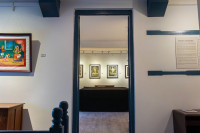
%20(1).jpg&w=200&height=120)
